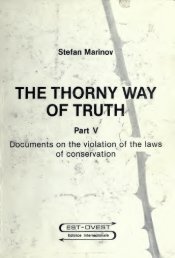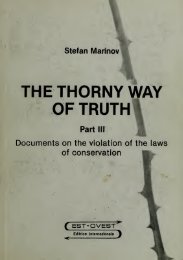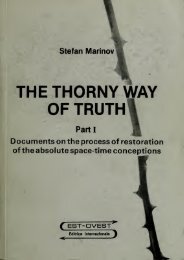The thorny way of truth - Free Energy Community
The thorny way of truth - Free Energy Community
The thorny way of truth - Free Energy Community
- No tags were found...
You also want an ePaper? Increase the reach of your titles
YUMPU automatically turns print PDFs into web optimized ePapers that Google loves.
;- FAN'287itefan Marinov's seasonal puzzleV:h yet another holiday season brewing up in the Northern Hemispehere. readers may wish to brood on a conundrumc/ised by an anti-relativist. No prizes are <strong>of</strong>fered for a solution.Marinov, the exiled Bulgarianr sicist now living in Graz in Austria, isbiself a puzzle. He is indefatigable in thepsccution <strong>of</strong> what seems to be his onlycse, which is to prove that Einstein'stDry <strong>of</strong> relativity is a pack <strong>of</strong> lies.larinov claims, among other things, tobe shown by direct measurement that!l velocity <strong>of</strong> light differs according tot direction <strong>of</strong> its travel along a fixedpi. He has also partly developed whath;ays is a perpetual motion machine, ak J <strong>of</strong> Wimshurst machine driven by ane rtnc motor which, when last inspecteda lis joumars London <strong>of</strong>fice, was said tor uire a car battery for its operation.ic .ut most <strong>of</strong> Marinov's work is theoret-Over the years, he has bombardedtl and other journals with a series <strong>of</strong>p ers with titles such as "<strong>The</strong> myths inpsics" and "Violations <strong>of</strong> the laws <strong>of</strong>oservation <strong>of</strong> angular momentum andergy". Details <strong>of</strong> his correspondence«i several editors may be found in hiss< es <strong>of</strong> volumes called <strong>The</strong> Thorny WayTruth, <strong>of</strong> which seven volumes haveQ' been published by InternationalPHishers (East-West) at Graz, <strong>of</strong> whichNrinov appears to be the sole owner.-rom time to time, Marinov threatensNmmolate himself in front <strong>of</strong> a Britishr)assy or consulate if he cannot get antf/cT to a question about the publication0)ne <strong>of</strong> his papers. Some years ago,» n embarked on such an enterpriseD;ide the British consulate at Genoa,k«inov ran a<strong>way</strong> when the police• roached. Afterwards he explainedt! he had done so because he was in Italyally, without a visa. Mercifully, he has3 threatened to immolate himself onN ire's account for many months.)in <strong>of</strong> everybody's difficulty is that.(. little is said about the details <strong>of</strong> the;::riments whose results are said to» radict conmion expectation for even"Apathetic critics to be able to provide:titructive statements <strong>of</strong> how they andvinov part company. Another is thatvinov's single-minded zeal for his ownX'iction considerably outstrips the zeal>iiose who may disagree. But from timecime, in Marinov's copious writings,he are relatively simple arguments thatIf ;ar accessible even to those still at highCol. Here is one series <strong>of</strong> gedanken^riments presented as if it were a- stmas puzzle (the original intention),»^some helpful (or misleading) hints foriMlution.JRE VOL 346 12 JULY 1990le figure shows a pair <strong>of</strong> circular conductorsarranged as two concentric circles.Equal electrical currents are circulated ineach, but in opposite directions. <strong>The</strong>simplest <strong>way</strong> <strong>of</strong> creating this arrangementis to cut through the concentric pair atsome point and to join the loose ends inpairs by short lengths <strong>of</strong> straight conductor.An electromotive force applied anywherealong the conductor will engender acurrent which must be everywhere uniform.At the bridged gap, there will beequal currents flowing in opposite directions,so their influence on the magneticfields in the concentric gap will be zero.<strong>The</strong> device is thus a means <strong>of</strong> arrangingthat there is a uniform magnetic field inthe space between the concentric circles ina direction perpendicular to their plane(downwards into the plane <strong>of</strong> the paperwhen the current in the circuit flows in thedirection indicated). <strong>The</strong> sensor in theexperiment is a conductor long enoughjust to bridge the gap between the concentriccircles and mounted on thin insulatingsupports in such a <strong>way</strong> that it can bemade to slide around the circle. <strong>The</strong>objective is to measure the voltage acrossthe sliding conductor, either by a standardvoltmeter or by a condenser whoseaccumulated charge will be a measure <strong>of</strong>the voltage in a steady state.<strong>The</strong> simplest case is when the slidingconductor is at rest. <strong>The</strong>n there is no voltage.Right? Next comes the case in whichthe sliding conductor moves at uniformspeed around the concentric gap, al<strong>way</strong>spointing along a radius <strong>of</strong> the concentriccircles. As the slider moves, it will cutthrough magnetic lines <strong>of</strong> force at a constantrate, so there will be a constant voltageacross the ends. <strong>The</strong> polarity <strong>of</strong> theslider will depend only on the direction <strong>of</strong>the current in the concentric circuit, andnot on whether the slider moves clockwiseor anticlockwise. Right again?Now comes the tricky part, at least s<strong>of</strong>ar as Marinov is concern d. What happensif the sliding conductor is fixed inspace, but the underlying concentric cir-cuit is rotated about its centre? Relativitytheory naturally predicts that the voltageacross the sliding conductor would be thesame as in the first experiment, and withthe same polarity. On the other hand,questions may be raised about the degreeto which the pattern <strong>of</strong> magnetic forcesgenerated by the current is draggedaround the ring by its rotation. Maybethere is a smaller voltage, but with thesame polarity. What, asks Marinov, is theanswer?<strong>The</strong> second conundrum is superficiallysimpler: simply rotate the apparatus in itsown plane, about the centre <strong>of</strong> the concentriccircles. (<strong>The</strong>re will be a small voltagedue to the Earth's magnetic field, butthis may safely be neglected.) Is there nowa voltage, and with what polarity? If theanswer to the first question is "Yes" theanswer to the second must be "No", andvice versa. Readers are invited to make uptheir minds before reading on.Marinov's own answers are unambiguous.Vice versa wins the day. When theunderlying concentric circuit is rotatedand the slider is kept fixed, there is novoltage across the movable conductor.But when the whole apparatus is rotatedabout its centre, the voltage across thenow-moving sliding conductor is identicalwith that obtained when the slider is movingrelative to the concentric circuit.<strong>The</strong> implications are evidently important.<strong>The</strong> null answer to Marinov's firstquestion implies that relativity has vanishedthrough the window, the affirmativeanswer to the second implies that anisolated apparatus carrying a circulatingcurrent will generate a voltage whenrotated, which raises forbidden questionsabout absolute space. Indeed, Marinovhas devised a gedanken measurement <strong>of</strong>the Earth's velocity through space bystretching his concentric circuit into alinear version <strong>of</strong> it. He also claims thatthese violations <strong>of</strong> simple expectation arethe basis on which his perpetual motionmachine is built.What is the <strong>truth</strong>? Nobody is quite sure,for nobody has done the experiments —not even Marinov. Indeed, one's confidencein the whole enterprise is somewhatundermined by Marinov's flat statementthat he does not bother to repeat experimentswhose outcome must be obvious.For one whose confidence in his own heterodoxyappears to be sustained otilyby his confidence that experiments willprove him right. Marinov seems curiouslypassive in the business.John Maddox103








